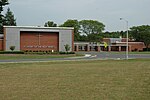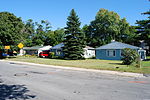Hurstville, New York
Bethlehem, New YorkNeighborhoods in Albany, New York
Hurstville is a former hamlet in the town of Bethlehem, New York. Today it is part of the city of Albany. Hurstville was located in the area of a bend in the Albany, Rensselaerville, and Schoharie Turnpike (today New Scotland Avenue) at its intersections with Whitehall and Krumkill roads, just outside the city limits of Albany.
Excerpt from the Wikipedia article Hurstville, New York (License: CC BY-SA 3.0, Authors).Hurstville, New York
Hurst Avenue, City of Albany
Geographical coordinates (GPS) Address Phone number Website Nearby Places Show on map
Geographical coordinates (GPS)
| Latitude | Longitude |
|---|---|
| N 42.656944444444 ° | E -73.813888888889 ° |
Address
Mater Christi School
Hurst Avenue 35
12208 City of Albany
New York, United States
Open on Google Maps





